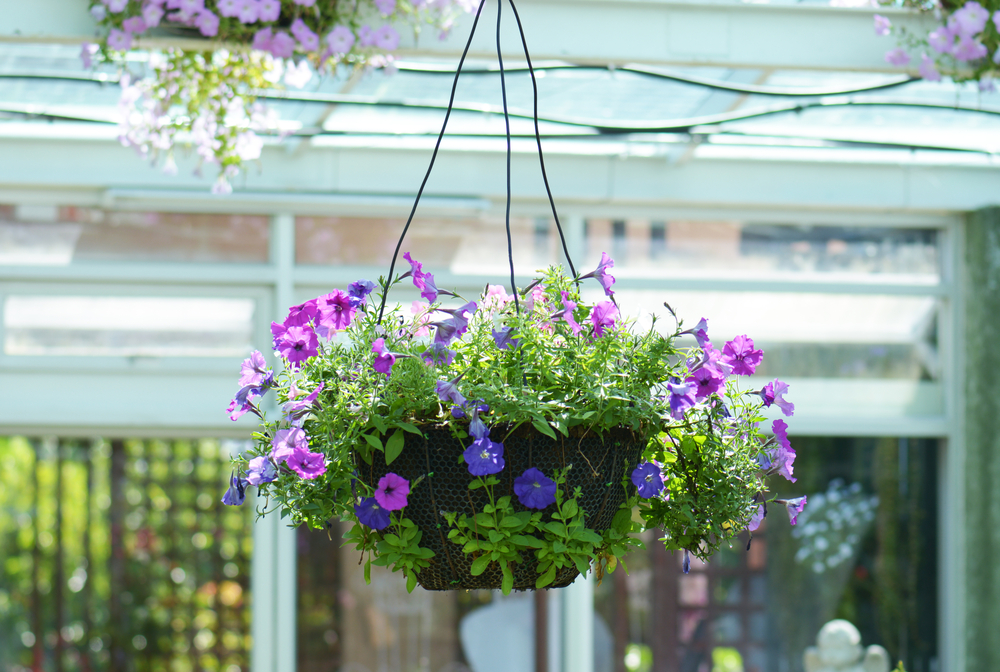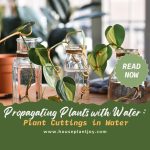HousePlantJoy is supported by our audience. When you purchase through one of our links, we may earn a small affiliate commission. As an Amazon Associate I earn from qualifying purchases. Your cost is not affected.
==================
Amidst the soothing ambience of my living space, where indoor hanging plants drape gracefully, I’ve discovered a world of tranquility. These plants, more than mere decor, have become cherished companions, breathing life into my home.
But it hasn’t always been smooth sailing. I remember the day I introduced a delicate Boston Fern – a lesson in the art of precise watering, learned the hard way with a puddle on the floor.
In this blog post, I’ll guide you through the delicate task of caring for your hanging greenery, sharing not only the practical know-how but the heartfelt joy these plants bring. Let’s explore the journey together, ensuring your indoor hanging plants flourish, lending your space the lush vibrancy it deserves.
How to Water Indoor Hanging Plants Properly
Leafy or vining plants cascading over the sides of a hanging pot are one of my favorite ways to display my plants. However discovering how to water indoor hanging plants properly took me some time and experimenting. No one wants water dripping from their Boston Fern on the living room floor. And that puddle under the spider plant, even in the kitchen, is unacceptable.
Hanging indoor plants adds a touch of greenery and life to your home. However, watering them can be tricky, as they are suspended in the air and often not easily accessible. Proper watering is crucial for the health and longevity of your indoor hanging plants. In this blog post, we discuss the importance of adequate watering for indoor hanging plants, factors to consider when watering them, practical tips for watering, and how often they should be watered.
We also share our favorite ways to water indoor hanging plants that have helped us maintain healthy and thriving plant babies. With these tips and tricks, you can keep your indoor hanging plants lush and green all year round!
Importance of Proper Watering for Indoor Hanging Plants
Consistent watering is vital for the health and vitality of indoor hanging plants. It ensures that these houseplants receive the necessary nutrients and hydration for growth. Overwatering can lead to root rot, while underwatering can cause dehydration. Maintaining proper moisture levels promotes healthy foliage growth and prevents wilting.
Adequate watering supports the overall well-being and longevity of indoor hanging plants. To ensure their well-being, it is essential to understand the specific needs of these plants and consider factors such as the type of plant, size of the pot and root ball, quality of soil and water, and protection indoor floors and furniture.
By following practical tips for watering, such as utilizing a watering wand, using a garden sprayer, trying bottom watering, and choosing hardy plants, you can effectively care for your indoor hanging plants.
The shower watering tip is another helpful technique where you can water your plants in the bathtub or shower. Following these watering practices can help your indoor hanging plants thrive.
Understanding the Specific Needs of Indoor Hanging Houseplants
When watering indoor hanging plants, it’s essential to understand that different types of plants have varying water requirements. Factors like humidity, light exposure, and pot size also influence each plant’s waterplant needs.
By understanding the specific needs of each plant, you can prevent overwatering or underwatering. For example, succulents require less frequent watering compared to other houseplants.
Researching and gaining knowledge about individual plant species will help you provide optimal care. This way, you can ensure your indoor hanging plants thrive and stay healthy.
Factors to Consider When Watering Indoor Hanging Plants
When watering indoor hanging plants, several factors need to be considered.
Firstly, the type of plant and its specific water requirements should be considered. Different houseplants have varying needs when it comes to watering.
Secondly, the size of the pot and the root ball play a role in determining how much water the plant needs. Larger pots with more giant root balls may require more water than smaller ones.
Additionally, the quality of soil and water used can impact the overall health of the plants. Using good-quality soil and avoiding over-fertilization is essential.
Considering the weight of the pot is also crucial, as hanging plants can strain the hooks or supports. Ensuring proper drainage is essential for preventing waterlogging.
Lastly, protecting indoor floors and furniture from potential water damage is vital. Placing a ceramic dish or tray at the bottom of the pot or investing in a grow pot with a saucer can help catch any excess water that drips down.
Considering these factors, you can ensure that your indoor hanging plants thrive and flourish.
Type of Plant and Its Water Requirements for Indoor Gardening
Depending on their species and specific needs, different houseplants require varying amounts of water.
While some indoor hanging plants prefer consistently moist soil, others thrive in drier conditions. It is essential to understand the water requirements of each plant to avoid over or underwatering.
Researching the plant’s natural habitat can provide valuable insights into its water needs. By adjusting the watering frequency and amount based on the plant’s specific requirements, you can promote healthy growth and ensure the well-being of your indoor hanging plants.
Size of Pot and Root Ball
The size of the pot and root ball plays a significant role in determining the watering needs of indoor hanging plants. Smaller pots and root balls dry out more quickly, requiring more frequent watering.
On the other hand, larger pots and root balls retain moisture for more extended periods, needing less frequent watering. Choosing the right pot size that matches the plant’s root system is crucial pot size that matches the plant’s root system to ensure healthy growth and proper hydration.
Observing the rate at which the potting soil dries out can indicate whether the pot size is suitable.
Quality of Soil and Water, Drainage
Using well-draining potting soil is crucial for the health of indoor hanging plants. This soil type prevents waterlogged roots and potential root rot by allowing excess water to drain freely.
Heavy soils or those that retain excessive moisture should be avoided to minimize the risk of overwatering. Additionally, using filtered or distilled water can help prevent pooling on top of the soil, which can cause bacteria, fungus, and an unhappy plant.
By focusing on soil and water quality, you can promote the optimal growth and well-being of your houseplants.
The Weight Question
Considering the weight of the pot is crucial when tending to your indoor hanging plants.
Overwatering can lead to a heavy pot, potentially straining the hanger or support. It’s essential to monitor the weight of the pot after watering to determine if the drainage is sufficient.
Regularly checking the weight helps prevent damage caused by excess water accumulation. Adjusting your watering practices based on the pot’s weight ensures a healthy balance for your plant.
By paying attention to the weight of the pot, you can effectively maintain the well-being of your indoor hanging plants and promote their growth.
Pro-tip: Consider your options if your plant grows too heavy for the current hanging bracket or support. You might divide the plant into two or more smaller plants. Or, if you prefer, use a floor stand for hanging or a post.
Protecting Indoor Floors and Furniture
To protect indoor floors and furniture from potential water damage caused by watering indoor hanging plants, there are several precautions you can take.
Placing a saucer or tray beneath the hanging plant is an effective measure. This saucer collects excess water that may drain from the pot during watering.
However, remember to empty the saucer after watering to prevent standing water, which can cause damage. Additionally, using protective mats or coasters adds an extra safeguard against potential water spills.
By taking these precautions, you can maintain the aesthetic appeal of your indoor spaces.
Practical Tips for Watering Indoor Hanging Plants
Utilizing a watering wand with a long spout makes it easier to reach high-hanging plants, ensuring that all areas receive adequate water.
Does It Need Water?
Regularly checking the moisture level of the potting soil is crucial in determining when to water indoor hanging plants. Watering should be done when the top inch of soil feels dry to the touch, promoting healthy root growth. It’s essential to ensure proper drainage by having a drainage hole in the pot to prevent overwatering. Additionally, adjusting the watering frequency based on seasonal changes and the specific growth requirements of the plant is essential in maintaining its health and vitality.
Utilizing a Watering Wand
Utilizing a watering wand with a long spout is a practical technique for watering indoor hanging plants. The extended spout allows for precise watering, reaching high-hanging plants without risking spillage or damage. With a watering wand, you can control the water flow, preventing overwatering and underwatering.
Another advantage is the ability to adjust the water pressure, providing tailored hydration for each plant. Investing in a quality watering wand can make watering indoor hanging plants more convenient, ensuring optimal care for your houseplants.
Use a Garden Sprayer
Try using a garden sprayer to ensure an even distribution of water to your indoor hanging plants. This method allows you to have better control over the amount of water, preventing overwatering.
You can avoid waterlogging and promote healthy growth by spraying water on the plants. The fine mist from the sprayer effectively moistens the foliage, providing the necessary hydration. To enhance precision, opt for a garden sprayer with adjustable nozzle settings. This way, you can tailor the spray pattern and ensure each plant receives the right water.
Of course, this might not be practical in some areas of your home. Please be sure to use caution to avoid spraying furniture and other items.
Try Bottom Watering
Bottom watering is a highly effective technique for nurturing your indoor hanging plants. To do this, place the plant pot in a shallow container filled with water, allowing the roots to absorb the moisture they need.
This method prevents waterlogging and the risk of root rot and conserves water by minimizing evaporation. After a few minutes, remember to remove the plant from the water to avoid waterlogging.
With bottom watering, you can ensure optimal hydration for your houseplants while promoting healthy growth without the worry of overwatering.
Go Soil-Free
Consider opting for soil-free mediums like sphagnum moss or coco coir when watering indoor hanging plants, including air plants. These alternatives to traditional potting soil provide excellent moisture retention while ensuring proper roots aeration.
Using soil-free mediums reduces the risk of overwatering and root rot, which are common issues with traditional soil.
Additionally, these mediums are lightweight, making them ideal for hanging baskets. Another benefit is that soil-free mediums help prevent pests and diseases often associated with traditional potting soil. Embrace the advantages of going soil-free, including healthier and thriving indoor hanging plants.
Choose Hardy Plants
When choosing plants for your indoor hanging baskets, it’s important to select hardy varieties that can tolerate occasional under or overwatering. Consider low-maintenance options like pothos or spider plants, snake plants, ZZ plants, and other resilient varieties. These plants require less water and attention, making them ideal for hard-to-reach shelves or hanging planters. Opting for snake plants ensures that indoor hanging plants thrive even with minor watering mistakes. Take the time to research and choose plants that match your home environment and care level, and you’ll have beautiful, resilient houseplants, including snake plants, that can thrive in your indoor gardening endeavors.
Check the Soil Before Watering
To ensure proper watering of your indoor hanging plants, it’s essential to check the soil’s moisture level. Stick your finger or a wooden dowel into the soil to assess its moisture content. If the soil feels dry up to the first knuckle, it’s time to water your plants.
On the other hand, if the soil is still moist, it’s best to avoid watering to prevent overwatering and root rot. Regularly monitoring the soil moisture will help you establish an appropriate watering schedule for your houseplants. By checking the soil before watering, you can ensure the health and vitality of your indoor hanging plants.
The Shower Watering Tip
Consider using the shower for a convenient and effective method of watering your indoor hanging plants.
Take down the plants and place them in the shower area. Adjust the showerhead to a gentle flow and water the plants evenly, allowing the water to soak the soil thoroughly.
This shower method ensures proper hydration and allows for optimal drainage. After watering, let any excess water drain before rehanging the plants.
Using the shower watering tip, you can provide your houseplants with the moisture they need for healthy growth.
Take to Your Tub or Shower to Water
To ensure proper drainage and prevent overwatering and root rot, consider taking your indoor hanging plants to the tub or shower for watering.
This method allows excess water to flow freely without damaging your floors or furniture. It is particularly advantageous for plants that require frequent watering.
Utilizing your tub or shower creates a convenient and controlled environment for watering your hanging plants. This technique promotes healthy growth and ensures that your houseplants receive the right water. So next time, give your indoor hanging plants some spa-like treatment in your tub or shower to keep them thriving.
Water Outside
Taking your indoor hanging plants outside for watering can have numerous benefits.
Exposing them to ample sunlight and fresh air provides the ideal conditions for their growth and health. When watered outdoors, plants can absorb water and essential nutrients more effectively through their roots.
This method also helps prevent the accumulation of stagnant water and reduces the risk of fungus growth in the potting soil.
If your indoor hanging plants thrive in natural outdoor environments, watering them outside is a great way to mimic their preferred habitat. Embrace the benefits of outdoor watering for your houseplants and watch them flourish.
Pro-Tip: Avoid taking your indoor plants outside when the temperatures are below 60°F. For some plants, anything below 70F might be a problem, while others might tolerate the low 40s. We prefer to use caution to avoid stressing our plants.
What I Use For Watering Indoor Plants
Watering indoor plants can be a gratifying experience when done right. To ensure that your hanging plants receive the care they deserve, a few tools and techniques can make the process easier and more effective.
When watering, consider taking your plants outside whenever possible for a thorough soak. This allows for better drainage and encourages healthier foliage and growth.
If you prefer to water indoors, utilizing the bathtub as a watering station can provide convenience and prevent water spillage. Using a stool or stepladder can help access hard-to-reach hanging plants comfortably. To ensure precise watering, could you consider using a watering can with a long spout?
Additionally, incorporating perlite into the potting soil mix can improve drainage and prevent waterlogging. These simple steps can help you maintain the health and vitality of your indoor hanging plants.
Outside When Possible
As mentioned, you can take advantage of the weather by watering your indoor hanging plants outside when the weather permits. This allows the plants to benefit from natural rainfall, which can encourage more robust growth.
Exposing the plants to natural light and fresh air also promotes overall plant health. Our houseplants enjoy their outdoor vacations when our weather permits.
Apartment dwellers can still provide this outdoor time for their houseplants if they have a small balcony or terrace area.
However, it’s essential to protect the plants from intense sunlight or strong winds that could damage them. Please be aware of any pests or diseases in your outdoor environment, as they can quickly spread to your indoor plants. Outdoor watering is a great way to boost your indoor hanging plants while enjoying the benefits of the outdoors.
How Often Should Indoor Hanging Plants be Watered?
When it comes to taking care of your indoor hanging plants, how often you water them really depends on a few things: the type of plant, the size of the pot, and what’s going on in your environment. To keep it simple, just stick your finger into the soil and give it a little poke. If the top inch feels dry, it’s time to give your plant a drink. Don’t forget to check on your plant’s moisture levels regularly and tweak your watering routine as needed. And, remember to think about things like how humid it is, what the temperature’s like, and what season it is when you’re deciding how often to water your leafy friends.
Video Credit: @GardenUp
Nurturing Your Hanging Green Oasis
So there you have it, your essential guide to keeping your indoor hanging plants thriving and your living space bursting with life. Remember, this journey is not just about providing water; it’s about tending to your green companions with care and dedication.
Think of it like a mini-oasis in your home, where each plant has its unique personality and needs. They’re not just decorations; they’re your fellow residents, breathing oxygen into your world.
As you’ve discovered, it’s not just a routine; it’s an art. Pay attention to the nuances of your plants – their thirst, their pot size, and the kind of soil they prefer. And hey, don’t forget to protect your lovely floors!
Shower watering, bathtub sessions, or an outdoor adventure – choose what suits your plants and lifestyle. And always, always, check the soil like you’d check on a friend.
In the end, it’s about consistency, about making your green oasis a part of your life. When you provide the right care and attention, these plants will reward you with not just beauty but a sense of peace. So, water wisely, and let your indoor hanging plants flourish. Your home will thank you for it.
Frequently Asked Questions
What are some signs that my indoor hanging plants need watering?
Signs that indoor hanging plants need watering include wilting leaves, dry soil, and yellowing or browning of leaves. Checking the weight of the pot can also indicate if the plant needs water – a lighter pot means the soil is dry. Some plants may also start to sag or look limp when they need watering. It is important not to overwater indoor hanging plants as this can lead to root rot and other issues.
How much water should I give my indoor hanging plants, and how often?
The water requirement for indoor hanging plants varies based on the plant type and environment. Generally, water them when the top inch of soil feels dry. Avoid overwatering to prevent root rot. Consider using a moisture meter or self-watering planter for proper watering regulation.
Are there any specific types of water or watering techniques that are best for indoor hanging plants?
To ensure optimal growth, use room temperature water for indoor hanging plants. Avoid hard water or high salt content, as it can damage the plants. Water thoroughly, but allow the soil to dry out slightly between watering. Consider using a drip tray or misting the leaves to increase humidity.
What are some common mistakes to avoid when watering indoor hanging plants?
Common mistakes to avoid when watering indoor hanging plants include overwatering, which can lead to root rot, and underwatering, which can cause wilting and plant death. It’s essential for our audience to consider factors like humidity, temperature, and soil type when determining watering needs.
Consistency and watering only when the soil is dry are key. Most people overwater their indoor plants and inadvertently harm them with excessive care. I’ve always believed that it’s better to err on the side of less water than to overwater.
? Dive into the Lush World of Houseplants and More! ?
Immerse yourself in the vibrant realm of houseplants, gardening, and home decoration with Houseplant Joy. ? Join our passionate community and explore captivating content, insightful product reviews, and the latest trends.
? Connect with us across social media:
? Instagram: Get your daily dose of green inspiration and behind-the-scenes plant care tips. Follow us on Instagram!
? Pinterest: Explore a world of beautifully curated boards for decorating and gardening ideas. Visit us on Pinterest!
? Twitter: Stay updated with the latest trends, tips, and green news. Follow us on Twitter!
?️ TikTok: Short, fun, and informative videos to spice up your plant journey. Watch us on TikTok!
Join our flourishing community, share your plant-filled adventures, and let Houseplant Joy be your guide to a greener, more vibrant life. And don’t forget to keep an eye out for our exclusive newsletter, bringing you even more plant magic! ? #HouseplantJoy




















